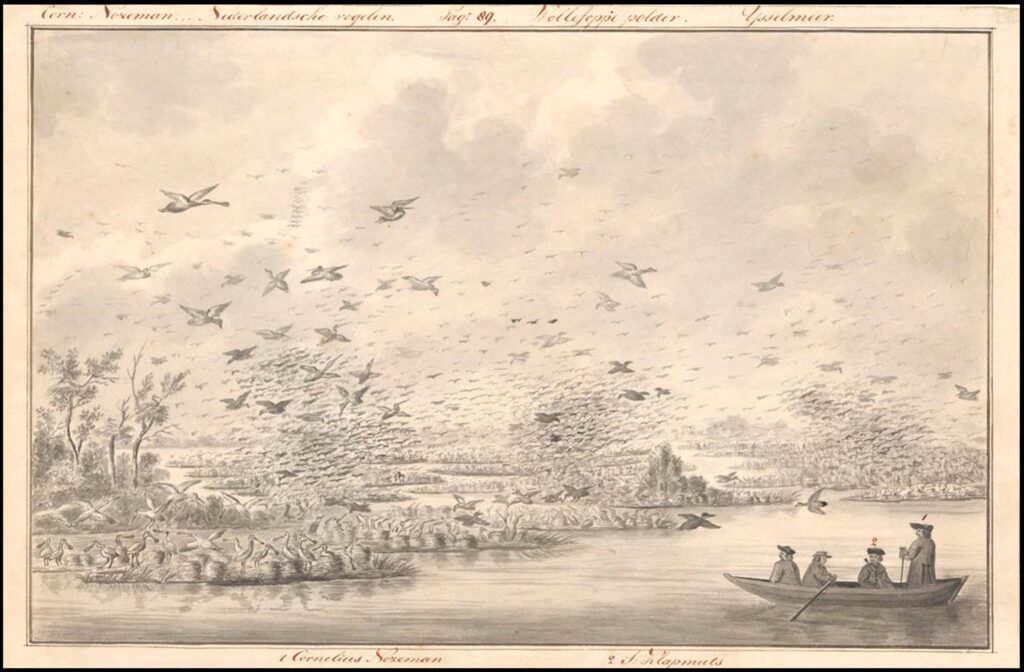The Dutch spoonbill population today consists of about 4,000 breeding pairs. You soon encounter them on the Wadden Sea, in the Delta area and nowadays also in more and more places inland. Groups of dozens and hundreds of “cutlery beaks” are not strange anymore.
The less squeamish among us remember that it used to be different. In the 1960s and 1970s, seeing a flock of spoonbills was a reason to write it down in your notebook with an exclamation mark. The population had collapsed at the hands of first draining swamps and harvesting eggs and young by humans and later by the use and discharge of toxins into the environment. By the late 1960s only 150 pairs remained in the Netherlands, and that was then the last straw in all of northwestern Europe. Populations of each case in England, France had already disappeared. Translated with DeepL.com (free version)
In the village of Jisp, located in today's North Holland municipality of Wormerland, spoonbills used to walk around the marketplace just like that. It was the custom there to let a number of young spoonbills run loose as entertainment at the fish market. These spoonbills fed here and there on fish and fish leftovers from the apparently abundant fishing. The spoonbill therefore figured prominently in the former municipal coat of arms of Jisp. This custom was described as early as the 16th century and later the 18th century. So all this time there was probably a large colony of spoonbills in the area, from where one could easily take the young. Whether those young spoonbills later moved away or stayed for a long time in the marketplace the story does not tell. It is mentioned that this also happened at other fish markets. So the spoonbill was by no means a rare sight in the Middle Ages.
Other sources also mention huge colonies of spoonbills, such as those in Horster Lake. In 1851, it was estimated that some 1,000 pairs of spoonbills were breeding there, based in part on the fact that as many as 1,600 spoonbill eggs were harvested in one week. Harvesting occurred twice a week and lasted for two months!
Another large colony in the 19th century was that on the former Schollevaerseiland in the Wollefoppenpolder, where there is now a Rotterdam residential area. There, too, eggs and young spoonbills were plentiful. Below is an impression of a visit to that magical island by an early ornithologist. In the print we see islands full of spoonbills and in the background huge flocks of birds, which in addition to spoonbills, include herons, cormorants and quacks. Again, many hundreds must have nested here. In the colony at Zevenhuizensche Bosch, young spoonbills were harvested along with those of herons and cormorants. Apparently young spoonbills were fine to eat, since they were shipped to England to end up on the plate of the then king.

Considering the draining of huge swamps that the Netherlands used to have, intensive hunting and later toxins, it is actually a miracle that the spoonbill has managed to survive. After the absolute low in the late 1960s, much has improved. Now we think 4,000 pairs is already a lot, but it is good to know that our country used to host perhaps more than 10,000 pairs. We are well on our way, but it seems that humans are still standing in the way of a full recovery. Limited food availability already seems to have put an end to growth on the Wadden Islands, and we may be seeing the same thing happening in the Delta area now. Enough reason to follow them closely!
Sources:
Van Bemmelen A. A. van, 1866. [Aanvulling der Mededeelingen over de Zoogdieren, Vogels en Kruipende Dieren. Bouwstoffen Fauna Ned., vol. 3, p. 525-526.] in Brouwer 1964.
Brouwer, G. A. (1964). Some data on the status of the Spoonbill, Platalea leucorodia L., in Europe, especially in the Netherlands. Zoologische Mededelingen, 39(48), 481–521.
Haverschmidt F. (1935) Korte mededeelingen. De Lepelaar in het wapen van Jisp. Ardea 24 (1-2) : 205 – 207.
Oudman T., de Goeij P., Piersma T. & Lok T. 2017. Colony-breeding Eurasian Spoonbills in The Netherlands: local limits to population growth with expansion into new areas. Ardea 105: 113–124.
Schlegel H. 1878. De vogels van Nederland deel 2, Amsterdam.


